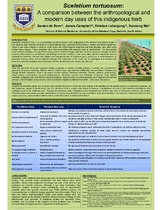A comparison between the anthropological and modern day uses of this indigenous herb

View/
Date
2012Author
Leisegang, Kristian
Campbell, James
Ma, X
De Beer, Sanien
Metadata
Show full item recordAbstract
Sceletium tortuosum (Fig. 1) is a scrambling succulent ground cover indigenous to the Western and Eastern Cape. It
has probably been used for centuries as a mood-altering drug, especially by the Khoisan hunters and Nama shepherds,
where it was often smoked or used as snuff. It also has hallucinogenic properties and high dosages were often used
during trance dances. These properties have been associated with alkaloids such as mesembrine. The San people
used it prior to hunting to sharpen their senses, and to diminish hunger and thirst. Even in excessive dosages its initial
euphoric effect seems to be replaced with feelings of serene sedation. It was more often used for enjoyment and not
primarily for medicine. Modern day medical and commercial use of Sceletium spp is primary as a mood enhancer, to
decrease anxiety, stress, and in addiction therapy. The objectives of this study was to investigate and compare the
historical and anthropological se of Sceletium with the modern day and current uses there of.
